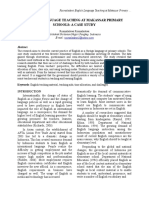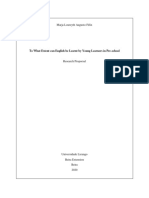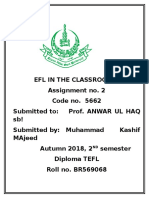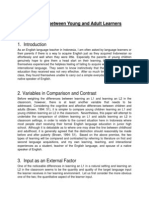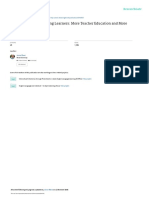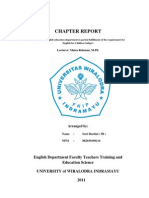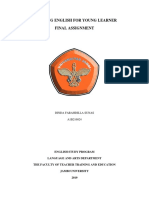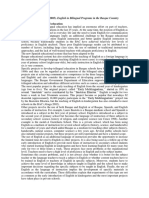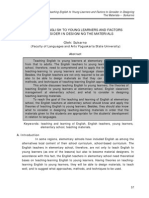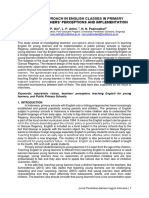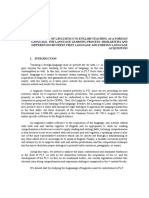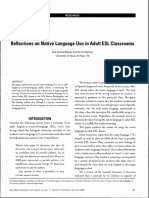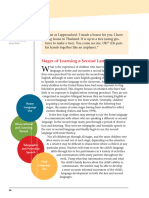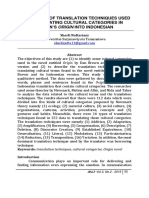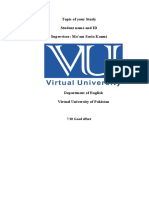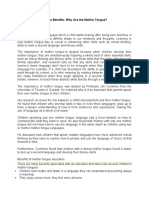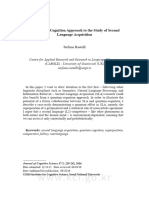0 ratings0% found this document useful (0 votes)
61 views20 pagesIntroduction: Embracing Theory and Practice in Teaching Languages To Young Learners
This document provides an introduction to teaching foreign languages to young learners. It discusses how perspectives have changed with more countries introducing English at earlier ages. While Turkey has reformed its policies and curriculum to require English in primary schools, teachers have not been adequately prepared and still rely on traditional methods. The goal of this volume is to help bridge the gap between theory and practice by providing both theoretical knowledge and practical classroom suggestions for teachers of young learners. Each chapter aims to connect research on issues in young learner classrooms with implications for teaching.
Uploaded by
Dragana KasipovicCopyright
© © All Rights Reserved
We take content rights seriously. If you suspect this is your content, claim it here.
Available Formats
Download as PDF, TXT or read online on Scribd
0 ratings0% found this document useful (0 votes)
61 views20 pagesIntroduction: Embracing Theory and Practice in Teaching Languages To Young Learners
This document provides an introduction to teaching foreign languages to young learners. It discusses how perspectives have changed with more countries introducing English at earlier ages. While Turkey has reformed its policies and curriculum to require English in primary schools, teachers have not been adequately prepared and still rely on traditional methods. The goal of this volume is to help bridge the gap between theory and practice by providing both theoretical knowledge and practical classroom suggestions for teachers of young learners. Each chapter aims to connect research on issues in young learner classrooms with implications for teaching.
Uploaded by
Dragana KasipovicCopyright
© © All Rights Reserved
We take content rights seriously. If you suspect this is your content, claim it here.
Available Formats
Download as PDF, TXT or read online on Scribd
You are on page 1/ 20
1
Suggested Citation: Haznedar, B. & Uysal, H. H. (2010). Introduction:
!"racing t#eory and $ractice in teac#ing languages to young learners. In B.
Haznedar & H. H. Uysal (ds.). Handbook for teaching foreign languages to young
learners in primary schools ($$. 1%20). &n'ara: &n( )u"lications.
Introduction: Embracing Theory and Practice in
Teaching Languages to Young Learners
Belma HAZNEDAR
Hacer Hande UYSAL
Changing perspectives in teaching foreign languages to young
learners
In recent years, *it# t#e in+luence o+ glo"alization and t#e increasing
i!$ortance o+ nglis# as an international language in *orld
co!!unication, !any uro$ean (,er!any, Italy, U-, ,reece, S$ain) and
&sian countries (e.g. -orea, .a$an, /#ailand) #a0e ta'en ste$s to introduce
t#e teac#ing o+ nglis# to c#ildren at an earlier age (+or a detailed
discussion o+ t#e issue see 1i'olo0a, 20023 1i'ilo0 & Curtain, 20003 )aul,
20043 1unan, 20043 and also -(r'g5z6s c#a$ter in t#is 0olu!e). 7or instance,
uro$ean Union countries introduced nglis# to t#eir $ri!ary curriculu!
and t#e age o+ "eginning instruction "eca!e 8 in 2002. Si!ilarly, +oreign
language $olicy #as undergone c#anges in /ur'ey as *ell. Under t#e ne*
la* t#at too' e++ect in 199:, and in a *ay rene*ed in 200;, it "eca!e
2
o"ligatory +or $ri!ary sc#ool students to start studying a +oreign language
1
as $art o+ t#e core $ri!ary curriculu! +ro! ,rade <.
/#is ne* re+or! in /ur'ey necessitated a ne* +oreign language
education curriculu! at $ri!ary le0el "ased on t#e constructi0ist and t#e
co!!unicati0e $ers$ecti0es. &ccordingly, a ne* course in $re%ser0ice =/
$rogra!s at uni0ersities > ?teac#ing nglis# to young learners@ *as
introduced and a series o+ in%ser0ice education se!inars *ere organized "y
t#e Ainistry o+ 1ational ducation to +a!iliarize t#e nglis# language
teac#ers *it# t#e ne* curriculu! goals and t#e constructi0ist and
co!!unicati0e teac#ing $#iloso$#ies, and to eBui$ t#e! *it# s$ecial s'ills
to "e a"le to teac# young learners (-(r'g5z, 200:3 Airici, 2008).
1e0ert#eless, t#ese teac#er $re$aration e++orts +ell s#ort o+ t#e desired
goals in curriculu! $lanning and $olicy, regarding teac#ing nglis# to
young learners due to t#e ra$idity o+ t#e c#anges *it#out esta"lis#ing t#e
necessary in+rastructure. Se0eral studies #a0e re$orted t#at nglis#
language teac#ers (#ence+ort# =/) are still una*are o+ t#e s$ecial needs o+
young learners, t#us teac#ing t#roug# traditional teac#ing !et#ods
in0ol0ing teac#er%centered instruction, eC$licit gra!!ar instruction, and
translation o+ +or!s into +irst language e0en in $ri!ary sc#ools (Hin'el &
7otos, 20023 -(r'g5z, 2002a,"). /#is situation indicates t#at t#e long lasting
$ro"le!s *it# regard to +oreign language teac#ing in /ur'ey are still going
on, and t#e 'no*ledge "ase o+ teac#ers *it# regard to teac#ing young
learners is seriously de+icient.
,i0en t#is situation, t#e !ain o"Decti0e o+ t#is 0olu!e is to contri"ute to
7= teac#ersE "ot# $re%ser0ice and in%ser0ice $ro+essional de0elo$!ent "y
$ro0iding t#e! *it# t#e necessary t#eoretical 'no*ledge "ase as *ell as
$ractical suggestions and classroo! acti0ities concerning young learners.
/#is 0olu!e es$ecially e!$#asizes and illustrates t#eoretical as$ects o+
+oreignFsecond language (=2) learning in c#ildren as $rereBuisite +or
$ractical a$$lications "ecause *e "elie0e t#at "eing a*are o+ t#e studies
in0estigating 0aria"les a++ecting t#e nature o+ young learners classroo!s
#as a strong !erit in in+or!ing our $edagogical decisions.
1
1ot to !ention t#at !any learners "egin learning nglis# e0en "e+ore t#is
age, in $articular in $ri0ate sc#ools in /ur'ey.
7or t#at reason, *e ai! to eC$and t#e $icture *#ic# researc# on young
learners #as "uilt u$ since t#e !id 1990s and to "ring toget#er researc#ers
and teac#ers *or'ing *it# young language learners +or an eCc#ange o+ t#e
!ost recent 0ie*s in t#is crucial area in /ur'ey. /#is is a 0ery i!$ortant
+eature o+ t#is 0olu!e "ecause *#ile t#e issues o+ age e++ects, language
trans+er, t#e!eFtas'%"ased !et#odology, story use, co!$uter tec#nology
etc. #a0e long "een t#e to$ic o+ intense researc# o0er t#e $ast ten years in
t#e +ield o+ +oreign language education, to t#e "est o+ our 'no*ledge, no
s$ecial 0olu!e, *#ic# integrates t#eory and $ractice in an accessi"le *ay,
eCists on teac#ing +oreign languages to young learners in /ur'ey. /#e
!aDority o+ t#e a0aila"le "oo's and re+erences $ri!arily +ocus on 0arious
ty$es o+ acti0ities and tas's t#at can "e used in young learners6 classroo!s
(e.g. )#illi$s, 19943 =e*is & Bedson, 199<3 rs5z, 200:3 -arag5z%Gnce, 200:).
Ho*e0er, as t#e acti0ities in t#ese "oo's are not grounded in a sound
t#eoretical "ase, it is not clear *#et#er suc# indi0idual acti0ities *ould
*or' in real classroo! settings or not. /o t#is end, t#is 0olu!e di++ers +ro!
ot#er *or's in its e!$#asis on connecting t#eory *it# $ractice, +illing a
ga$ "et*een t#eoretical "oo's and resource "oo's.
In t#is regard, t#is #and"oo' is an atte!$t to $ro0ide a co!$re#ensi0e
o0er0ie* o+ so!e crucial issues surrounding t#e teac#ing o+ young
learners. &s can "e seen in eac# c#a$ter, it co0ers a *ide s$ectru! o+
t#eoretical issues in young learner classroo!s and $a0es *ay +or
discussion on t#e i!$lications o+ t#ese issues +or classroo! $ractice. /#e
0olu!e e!$#asizes on $ri!ary le0el language $olicies, curriculu! and
sylla"us ty$es, and s$ecial classroo! tec#niBues and a$$ro$riate
!et#odology. It also $ro0ides $ractical ad0ice and guidance +or teac#ers
t#roug# sa!$le lesson $lans and acti0ities on integrated language s'ills,
0oca"ulary and gra!!ar teac#ing, !aterials de0elo$!ent, use o+
tec#nology and stories, as *ell as *ays o+ assess!ent and e0aluation +or
young learners.
In *#at +ollo*s, *e +irst "rie+ly discuss so!e crucial issues in regard to
young learner classroo!s and t#en su!!arize eac# c#a$ter o+ t#e 0olu!e
*it# a +ocus on t#eir s$ecial contri"ution to t#is 0olu!e.
Who are young learners?
!
Hn standard assu!$tions, young learners, also 'no*n as c#ild second
language (=2) learners, re+er to c#ildren *#ose +irst eC$osure to anot#er
language occurs a+ter t#eir +irst language #as "een esta"lis#ed +or at least 4%
; years (Ac=aug#lin, 19:23 Sc#*artz, 2004a,"3 Aeisel, 2002). I#ile t#e
lo*er%"ound di++erentiating c#ild =2 +ro! +irst language (=1) is considered
to "e around age 4 (Ac=aug#lin, 19:2), as $ointed out correctly "y
=a's#!anan (199;), not all as$ects o+ t#e +irst language are acBuired
around age 4. Jes$ite lac' o+ agree!ent a!ong researc#ers and
$ractitioners, t#e u$$er%"ound di++erentiating c#ild =2 learners +ro! adult
=2 learners, on t#e ot#er #and, is considered to "e :%10 years old, *#ic# is
in +act an issue relating to t#e critical $eriod de"ate discussed in t#e
+ollo*ing section (e.g. .o#nson & 1e*$ort, 19293 Aeisel, 20023 Sc#*artz,
20043 also see Je-eyser & =arson%Hall, 200; +or a recent o0er0ie* o+ t#e
critical $eriod #y$ot#esis). &s in 'no*n, in 7= conteCts young learners
are generally re+erred to c#ildren aged siC to t*el0e. ,i0en t#e sco$e and
t#e o"Decti0es o+ t#e t#is #and"oo', our !aDor +ocus in t#is study concerns
c#ildren aged 8%12.
Age of acqus!on
I+ t#ere is anyt#ing a"out second language acBuisition t#at #as attracted
so !uc# attention and #as led to !uc# contro0ersy all o0er t#e *orld, it is
$ro"a"ly t#e de"ate a"out t#e age o+ acBuisition, $er#a$s !ainly "ecause
!any c#ild =2 learners generally $er+or! "etter t#an adult language
learners (e.g. Hya!a, 19:8, 19:23 )at'o*s'i, 19203 -ras#en, Scarcella, &
=ong, 19223 7eliC, 192;, 19913 Singleton, 19293 =ong, & =arsen%7ree!an,
19913 .o#nson & 1e*$ort, 19293 Bley%Kro!an, 19903 .o#nson, 19923 Sla0o++,
,.L. & .o#nson, 199;). &ccording to !any researc# +indings, t#e younger
t#e c#ild is *#en =2 acBuisition starts, t#e "etter $ro+iciency t#e c#ild
arri0es at. In #is long re0ie* on =2 de0elo$!ent, =ong (1990) re$orts a
nu!"er o+ studies s#o*ing t#at starting a+ter age 8 a$$ears to !a'e it
i!$ossi"le +or !any learners to ac#ie0e nati0e%li'e $ro+iciency in
$#onology, and starting later t#an t#e early teens see!s to create si!ilar
$ro"le!s in !or$#ology and syntaC. =ong notes t#at studies s#o*ing an
initial rate ad0antage +or adults o0er c#ildren and +or older c#ildren o0er
young c#ildren s#ould "e inter$reted as only a s#ort%ter! rate ad0antage.
I#at #e suggests is t#at "ot# initial rate o+ acBuisition and ulti!ate
attain!ent de$end on t#e age at *#ic# learning "egins. It is suggested t#at
"
t#ere are sensiti0e $eriods go0erning language de0elo$!ent during *#ic#
t#e acBuisition o+ s$eci+ic language a"ilities is !ore success+ul and a+ter
*#ic# language acBuisition is so!e*#at inco!$lete. =ong e!$#asizes t#at
t#e age%related loss o+ language learning a"ility is cu!ulati0e rat#er t#an a
one%s#ot e0ent a++ecting se0eral linguistic do!ains successi0ely and t#is
loss is not li!ited to $#onology. =oss o+ language learning a"ility is
clai!ed to "egin as early as 8. H0erall, =ong argues t#at e0en t#oug# t#ere
is no single critical age, t#e a"ility to learn a second language *ea'ens "y
ti!e and t#e $ossi"ility o+ reac#ing t#e nati0e%li'e ulti!ate attain!ent
descreases. It s#ould "e noted, #o*e0er, t#at recent classroo!%"ased
researc# $resents e0idence +or "etter $er+or!ance o+ older learners, as *ell
(e.g. Cenoz, 20043 AuMoz, 2008). Indeed, older learners #a0e "een re$orted
to !a'e +aster initial $rogress in t#e acBuisition o+ gra!!atical and leCical
co!$onents o+ an =2, due to t#eir #ig#er le0els o+ cogniti0e !aturity and
analytical s'ills (e.g. Harley & Iang, 199:).
&s can "e seen, reac#ing a consensus a!ong researc#ers and $ro0iding
an eC$lanation +or t#e $#eno!enon a$$ear to "e +ar +ro! conclusi0e. In
t#e last ten years, so!e researc#ers #a0e s#o*n rene*ed interest in age
e++ects (e.g. Hyltensta! & &"ra#a!sson, 2001), ot#ers #a0e "een !ainly
critical in t#e *ay t#ey #a0e a$$roac#ed =2 learning in c#ild#ood (e.g.
Singleton, 2001).
/#e reason *#y age o+ acBuisition #as recei0ed so !uc# attention in t#e
literature is !ainly due to its $ractical and t#eoretical $otentials. 7or t#e
$ro$onents o+ t#e Nt#e younger t#e "etter6 a$$roac#, early introduction o+
anot#er language reBuires s$ecial treat!ent +or !aCi!u! $edagogical
"ene+its (Aarino0a%/odd et al., 20003 Sco0el, 1922). 7ro! a t#eoretical
$ers$ecti0e it #as +ar%reac#ing inter$retations in cogniti0e and neurological
as$ects o+ language acBuisition (e.g. 1e*$ort, 19913 )ul0er!Oller &
Sc#u!ann, 199<).
H0erall, one can argue t#at nor!ally de0elo$ing c#ildren can learn
anot#er language at an early age, gi0en su++icient eC$osure and interaction.
Hur +ocus in t#is #and"oo' is restricted to young c#ildren *#o start
learning a +oreignFsecond language in t#e early years o+ sc#ooling (!ainly
<t# and ;t# graders), "ecause t#is is t#e age range !ost teac#ers in /ur'ey
need su$$ort in t#eir teac#ing $ractice, due to t#e relati0ely recent
#
introduction o+ +oreign languages in /ur'is# $ri!ary sc#ools. H"0iously, it
is i!$ortant to 'ee$ in !ind at t#is $oint t#at eC$osure to t#e
secondF+oreign language in /ur'ey is !ostly li!ited to class settings.
"rmary foregn language !eachng n #ur$ey
Under t#e ne* legislation o+ t#e /ur'is# educational syste!,
co!$ulsory education lasts +or 2 years, until t#e age o+ 1; years. It is
$ro0ided "y state sc#ools and $ri0ate sc#ools and is di0ided into t#ree
cycles: /#e +irst cycle o+ $ri!ary education caters +or c#ildren "et*een t#e
ages o+ : and 11, and t#e second cycle o+ $ri!ary education co!$rises
grades 8, :, and 2, c#ildren "et*een 12, 14, and 1<. Hig# sc#ool education
starts a+ter t#e 2t# year o+ sc#ooling, consisting o+ +our years o+ education,
eit#er in general education t#at $ro0ides access to #ig#er education, or in
0ocational education *#ic# is !ainly c#aracterized "y a dual syste! in
*#ic# education is $ro0ided "y t#e *or'$lace and t#e sc#ool. Since 199:,
$ri!ary sc#ools #a0e "een c#arged *it# introducing c#ildren in ,rade < to
a +oreign language. nglis# is "y +ar t#e !ost co!!on and !ost
intensi0ely taug#t +oreign language in /ur'ey, +ollo*ed "y 7renc# and
,er!an in so!e $ri0ate sc#ools ('!e'Pi, 20043 ,enP, 200<).
2
7or
languages taug#t as co!$ulsory su"Dect, t#e nu!"er o+ $eriods $er year
and *ee' is $rescri"ed in t#e national curriculu!. /#e ti!e allocated to
eac# language de$ends on students6 grade and t#e ty$e o+ t#e sc#ool,
ranging +ro! 2 #ours to 2 #ours $er *ee'. Hn a0erage students aged 11%1;
recei0e 2%< #ours o+ instruction in nglis# $er *ee'. 7or students aged 1;%
1:, t#e a0erage a!ount o+ ti!e allocated to nglis# is 4 #ours $er *ee'.
%e!hodology n young learners& classrooms
& nu!"er o+ resource "oo's on teac#ing nglis# to young learners
e!$#asize t#e +ollo*ing $rinci$les, all o+ *#ic# deri0e +ro! recent
t#eorizing in t#e +ield *it# a +ocus on classroo! $ractice (e.g. Ca!eron,
20013 Halli*ell, 19923 House, 199:3 Aoon, 20003 )#illi$s, 19943 )inter, 20083
LiCon, 19993 Scott & Qtre"erg, 19903 and Slattery & Iillis, 2001).
=istening and s$ea'ing s#ould "e taug#t +irst.
2
Hne s#ould note t#at t#e !aDority o+ t#e $ri0ate sc#ools t#at o++er 7renc# and
,er!an usually "egin in t#e u$$er secondary sc#ools.
$
/#e $ri!ary +ocus s#ould "e on !eaning rat#er t#an +or!.
&cti0ities s#ould "e +un and enDoya"le.
&cti0ities s#ould in0ol0e RdoingR or $er+or!ing tas's.
&cti0ities s#ould create a need or a desire to co!!unicate.
Qoung learners s#ould +eel relaCed in t#e classroo!.
=anguage use s#ould "e illustrated "y use o+ o"Dects, $ictures,
actions or gesture.
Suita"le acti0ities include use o+ r#y!es, songs, stories, $oe!s,
dra!a, $roDectFt#e!e%"ased a$$roac#es and /)L acti0ities.
/#e use o+ Ec#un'sE o+ language s#ould "e $ro!oted.
=essons s#ould "e conducted in t#e =2 as !uc# as $ossi"le.
/#ere s#ould "e a 0ariety o+ acti0ities.
Classroo! routines s#ould "e esta"lis#ed.
&cti0ities s#ould use c#ildrenEs sense o+ i!agination.
/as's s#ould "e si!$le enoug# +or c#ildren to understand *#at
t#ey are eC$ected to do.
&cti0ities s#ould "e de!anding, "ut not too de!anding, and !ust
"e ac#ie0a"le.
I#ile *e do not Buestion t#e i!$ortance o+ t#ese $rinci$les in teac#ing
to young learners in class settings, *e *ould li'e to ta'e a ste$ +urt#er and
argue t#at t#ese $rinci$les s#ould "e su$$orted *it# researc# +indings in
t#e +ield and t#at teac#ers s#ould see t#e rele0ance o+ t#eir classroo!
$ractice. In !ost cases, teac#ers are $ro0ided co$ies o+ $#otoco$ia"le
!aterials *#ic# are not necessarily lin'ed to young learners6
de0elo$!ental stages or catering indi0idual di++erences a!ong students. It
is, t#ere+ore, not clear to *#at eCtent young learners can "ene+it +ro! suc#
teac#ing !aterials, an i!$ortant issue *#ic# is addressed in 0arious
$ortions o+ t#is 0olu!e.
'n!egra!ed language s$lls
In order to "e a"le to $resent and discuss in detail t#e t#eoretical
"ac'ground "e#ind t#e teac#ing o+ language s'ills, t#e s'ills *ere
%
$resented in a distinct and se$arate !anner in t#is 0olu!e. Ho*e0er, *e
*ould li'e to caution readers not to inter$ret t#is organization in style
*#ic# introduced s'ills se$arately as an indicator t#at *e su$$ort a
segregated%s'ill a$$roac#. In contrast, *e strongly concur *it# t#e recent
a$$roac#es su$$orting integrated%s'ill a$$roac#es in language classes, and
es$ecially *it# young learners. <#oug# learning a language and using it
at t#e sa!e ti!e !ay "e di++icult (Hyland, 2004) resulting in c#allenges in
i!$le!entation o+ an integrated s'ill a$$roac# *it# lo* $ro+iciency
ele!entary sc#ool learners, e0ery e++ort s#ould "e !ade to integrate all
language s'ills into our teac#ing. Instead o+ *aiting +or students to learn
t#e language rules, listen, read and t#en start to s$ea' and *rite in t#e
target language, *e s#ould *or' all s'ills toget#er. Studies #a0e re0ealed
t#at language acBuisition and $roduction can occur si!ultaneously along
*it# so!e sort o+ attention ta'ing to +or! (S*ain, 2000). Lesearc# also
suggests t#at +unctional listening and reading as *ell as s$ea'ing and
*riting s#ould "e esential in designing classroo! acti0ities "ecause all
t#ese s'ills interact *it# and su$$ort one anot#er (7ree!an & 7ree!an,
1992, $. 122). /#ere+ore, i+ *e +irst +ocus on so!e s'ills, "ut delay ot#ers,
t#at !eans ?*e are li!iting c#oices and *ays to su$$ort our students6
learning@ (7ree!an & 7ree!an, 1992, $. 124). 7or t#at reason, *e s#ould
integrate all s'ills in classroo! tas's as !uc# as $ossi"le suc# as
encouraging our students to ta'e notes a+ter listening, to *rite a+ter
s$ea'ing and discussing, and t#en to s$ea' again on *#at *as *ritten and
listen to eac# ot#er at t#e sa!e ti!e.
1& 'eatures of this volume
It is i!$ortant to #ig#lig#t at t#is $oint t#at *#ile al!ost all o+ t#e
c#a$ters o+ t#is 0olu!e deal *it# nglis# language teac#ing, *e argue t#at
t#e 0ie*s and $ers$ecti0es articulated in t#e contri"utions o+ t#e $resent
#and"oo' +or nglis# can "e a$$lied to ot#er languages, as c#anging
$ers$ecti0es in language learning and teac#ing occur no !atter *#ic#
language is under discussion. Iit# s$ecial e!$#asis on nglis#, -(r'g5z6s
c#a$ter eCa!ines !acro le0el and !icro le0el language $olicies ado$ted in
t#e /ur'is# educational syste!. 1oone can deny t#at si!ilar 0ie*s on
decision !a'ing $rocesses at !acro le0el are a$$lica"le to teac#ing
(
languages ot#er t#an nglis#. Si!ilarly, &'can6s c#a$ter eCa!ines #o*
young learners6 classroo!s can "e enric#ed "ased on !odern language
teac#ing !et#odologies. Besides, Bayyurt6s c#a$ter in0estigates t#e crucial
$ro$erty o+ tas'Ft#e!e%"ased teac#ing, !any di++erent acti0ities "eing
lin'ed toget#er "y t#eir content, *#ic# *e "elie0e, is i!$ortant +or
teac#ing +oreign languages in general, not Dust teac#ing nglis# to young
c#ildren. Hn si!ilar grounds, in contrast to co!!on concerns on gra!!ar
teac#ing in t#e young learner classroo!, recent studies suggest t#at +ocus%
on%+or! instruction
#as a $ositi0e e++ect on t#e second language $ro+iciency
o+
young learners (Aitc#ell, 20003 1orris & Hrtega, 20003 Iillia!s, 200;3
llis, 2008). 7or Iiddo*son (1990), +or eCa!$le, *#en learners are le+t to
t#eir o*n resources, Nt#ey do not 0ery readily in+er 'no*ledge o+ t#e
language syste! +ro! t#eir co!!unicati0e acti0ities6 ($. 181). /#ere+ore,
so!e +or! o+ +ocus on linguistic +eatures are considered to "e use+ul in
order to desta"ilize learners6 interlanguage (llis, 2008). Legarding t#is
#otly de"ated issue in +oreign language teac#ing, Uysal in t#is 0olu!e
$ro0ides a su"stanti0e o0er0ie* o+ recent trends *#ic# #a0e
i!$lications
+or "ot# t#e i!$le!entation o+ +ocus%on%+or! instruction
at $ri!ary sc#ool
le0el, and t#e !ani$ulation and su$$licance o+ +eed"ac' +or errors
$roduced "y young learners at t#is le0el. &s is 'no*n, e0aluation is an
essential co!$onent o+ any ty$e o+ curriculu! !odel and language
teac#ing !et#odology (Clar', 192:3 Lic#ards, 192<3 1unan, 192;3 I#ite,
1922). It is only t#roug# !onitoring and syste!atic e0aluation t#at *e can
co!$are and ta'e nesessary actions in ter!s o+ +ailure and de+icits
o"ser0ed in t#e syste!. In line *it# recent de0elo$!ents in t#e +ield
Sar(Po"an and -OntaS6s c#a$ter +ocusses on t#is #ig#ly neglected area in
t#e young learner classroo! and $resents recent $ers$ecti0es on asses!ent
and e0aluation.
Iit# its e!$#asis on "ot# t#eory and $ractice, t#is "oo' is #ig#ly li'ely
to #a0e a strong i!$act on +uture *or' *it# young learners. H0erall, a
0olu!e suc# as t#is is intended to #el$ teac#ers and student teac#ers #a0e
access to t#eoretical and $ractical $ers$ecti0es, o++ering o$$ortunities +or
critical engage!ent *it# recent ideas and +indings.
In addition, in grou$ing toget#er in a single 0olu!e t#e !ost recent
de0elo$!ents, t#is "oo' $ro0ides a uniBue o$$ortunity +or readers to
1)
re0ie* t#e c#anging $ers$ecti0es and tendencies in +oreign language
teac#ing.
Who s !hs (oo$ for?
/#is "oo' is $ri!arily addressed to undergraduate students o+ +oreign
language education de$art!ents in education +aculties. It can "e used at
t#e senior undergraduate le0el as a re+erence "oo' +or a se!inar on to$ics
suc# as secondF+oreign language learning in c#ild#ood, language $olicy
and curriculu! de0elo$!ent, !et#odology +or young learners, *it#
s$ecial re+erence to story%"ased and tas'Ft#e!e%"ased teac#ing,
intercultural co!!unication and assess!ent and e0aluation +or young
learners. It could also "e used as a su$$le!ental re+erence +or a !ore
general o0er0ie* +or graduate students *#o do not #a0e !uc#
"ac'ground in language learning and teac#ing.
In addition, t#is 0olu!e could "e use+ul +or $ractising $ri!ary le0el
language teac#ers as a source +or $ro+essional de0elo$!ent in a +ield *#ic#
#as !ade considera"le ad0ances in recent years. 7inally, t#e "oo' *ould "e
in+or!ati0e to $olicy !a'ers and curriculu! de0elo$ers interested in u$%
to%date researc# de0elo$!ents in +oreign language education "ot# in
t#eoretical and $ractical ter!s.
So!e c#a$ters o+ t#e 0olu!e are intended to suggest *ays t#at teac#ing
$ractices in young learners classroo!s are e++iciently designed, ot#ers +ocus
on #o* s'ill de0elo$!ent $roceeds in c#ildren in anot#er gra!!atical
syste!, and so!e ot#ers #ig#lig#t t#eoretical $ers$ecti0es o+
+oreignFsecond language learning *it# a +ocus on #o* educators and
teac#ers could $ut t#eory into $ractice. In *#at +ollo*s, *e "rie+ly
su!!arize eac# c#a$ter *it# a +ocus on t#e s$eci+ics o+ t#eir contri"ution
to t#is 0olu!e.
2& The chapters of this volume
&s #as "een e!$#asized, t#e contri"utions in t#is 0olu!e start *it#
t#eoretical "ac'ground in+or!ation +ollo*ed "y $ractical suggestions or
classroo! i!$lications and sa!$le acti0ities and eCa!$les related to
young learners, in $articular *it# res$ect to recent $ers$ecti0es in
11
language teac#ing. /o t#is end, t#e 0olu!e is organized in ter!s o+ +our
!aDor t#e!es:
(i) =anguage $olicy, language acBuisitionFlearning, !et#odology
and sylla"us are t#e $ri!ary concerns in0estigated in -(r'g5z,
Haznedar, &'can, and Bayyurt3
(ii) =anguage s'ills are addressed in QO'sel, ,Or"Oz, ,Ol%)e'er,
and Qang(n%rsanl(3
(iii) Conte!$orary a$$roac#es in teac#ing to young learners are
in0estigated in Ta'(r, Uysal, Haznedar, &'$(nar, and rPetin3
(iv) &ssess!ent and e0aluation are addressed in 'Si and Sar(Po"an
and -OntaS.
Language )olcy* language acqus!on+learnng* me!hodology* and
sylla(us
In #er contri"ution, *+r,g-. re$orts recent ad0ances in +oreign
language $olicy in /ur'ey, *it# s$ecial e!$#asis on t#e ne* curriculu!
introduced +or teac#ing nglis# to young learners. )arallel to recent trends
in !any countries t#at #a0e lo*ered t#e age o+ eC$osure to nglis# in
$ri!ary sc#ools, +ollo*ing t#e &ct o+ 4<08 *#ic# *as i!$le!ented in 199:,
/ur'ey #as also introduced c#anges in t#e national curriculu! as $art o+ its
+oreign language education $olicy in order to ada$t its curriculu! to t#e
uro$ean Union standards and to res$ond to t#e c#anging nature o+ t#e
glo"alized *orld at !acro le0el. /#e early introduction o+ nglis# #as also
necessitated t#e need to re0ise t#e +oreign language curriculu!, and to
introduce inno0ati0e teac#ing !et#ods. In t#is c#a$ter, -(r'g5z discusses
t*o !aDor curriculu! inno0ations in /ur'ey, t#e +irst one in 199:, and t#e
second one in 200;, regarding nglis# language teac#ing (=/) in $ri!ary
education. S#e argues t#at t#e s$eed o+ t#e nation*ide i!$le!entation o+
t#e curriculu! inno0ation $resented 0arious $ro"le!s and c#allenges in
$articular regarding teac#er education, ti!e +ra!e and in%ser0ice teac#er
training $rogra!s designed and i!$le!ented "y t#e !inistry o+ education.
/a.nedar0s contri"ution +ocuses on !o0ing +ro! t#eory to $ractice in
language teac#ing in early c#ild#ood. Haznedar suggests t#at t#eoretical
*or' in c#ild second language (=2) acBuisition studies o0er t#e last se0eral
decades can contri"ute signi+icantly to a "etter understanding o+ language
teac#ing to young learners. Haznedar addresses t#ree !aDor $#eno!ena in
12
c#ild =2 acBuisition, *it# s$ecial re+erence to (i) t#e role o+ t#e +irst
language in c#ild =2 acBuisition, (ii) gradual de0elo$!ent in c#ild =2
gra!!ars, (iii) error ty$es $roduced "y young =2 learners, *#ic# all #a0e
t#e $otential to $resent crucial i!$lications +or classroo! teac#ing.
In regard to !et#odology +or young learners classroo!s, 1,can re0ie*s
language teac#ing !et#odologies *it# a +ocus on learning eC$eriences t#at
surround young learners *it# !eaning+ul and interacti0e literacy%"ased
acti0ities in order to su$$ort second language de0elo$!ent. S#e +irst
discusses so!e !et#odologies *#ic# +ocus on +or! and oral language, and
t#en $roceeds *it# !ore co!!unicati0e a$$roac#es *#ic# can #el$
young learners attend to language and content !atter 'no*ledge.
Co!$ati"le *it# recent t#eorizing on young learners, &'can argues t#at
young c#ildren learn language as a !ediu! o+ co!!unication "y using it
t#roug# $ur$ose+ul, real, and #ere and no* eC$eriences.
2ayyurt6s *or' +ocuses $ri!arily on tas'%"ased sylla"us. Bayyurt +irst
$resents in+or!ation a"out di++erent sylla"us ty$es and argues t#at a tas'%
"ased sylla"us designed around +a!iliar to$ics *ould "e t#e !ost e++icient
one +or young learners. S#e su$$orts #er argu!ent *it# a t#oroug#
discussion o+ t#e t#eoretical "asis o+ tas'%"ased language learning and
teac#ing. /#en, a+ter eC$laining in detail *#at a tas' in0ol0es and gi0ing
in+or!ation a"out di++erent tas' ty$es, Bayyurt suggests *ays to de0elo$ a
tas'%"ased sylla"us.
Language s$lls
Y3,sel discusses listening and t#e teac#ing o+ listening *it# regard to
young learners and argues t#at listening is a +oundation s'ill +or ot#er
language s'ills. /#e c#a$ter $rogresses around t#ree !ain to$ics *#ic# are
t#e listening $rocess, listening s'ills, and listening in t#e classroo!. QO'sel
+irst descri"es t#e listening $rocess and t#en eC$lains t#e $ur$ose and
ty$es o+ listening (one%*ay and t*o%*ay listening). In t#e second #al+ o+
#er c#a$ter, QO'sel eC$ands on t#e relation "et*een listening and
$ronunciation +ollo*ed "y $ractical suggestions regarding *#ere to start
and #o* to design listening acti0ities. /#e c#a$ter ends *it# a 0ariety o+
classroo! tec#niBues and acti0ities *#ic# can "e used *it# young learners.
43rb3. +ocusses on de0elo$ing oral s'ills in t#e young learner
classroo!. ,Or"Oz starts #er c#a$ter *it# a re0ie* o+ t#e t#eoretical issues
1
regarding t#e teac#ing o+ s$o'en language in t#e young learner classroo!.
/#e +irst section o+ t#e c#a$ter is !ainly a"out #o* c#ildren acBuire oral
co!!unication s'ills in t#eir +irst language and to *#at eCtent t#e +irst
language acBuisition $rinci$les can "e a$$lied to an 7= classroo!
at!os$#ere. =ater, t#e c#allenges o+ teac#ing oral co!!unication s'ills to
young learners in 7= conteCts *#ere o$$ortunities +or $ractice are
con+ined to classroo! settings are noted. ,Or"Oz, t#en, discusses teac#ing
oral co!!unication s'ills to young learners es$ecially *it# re+erence to
teac#ing $ronunciation, intelligi"ility and a$$ro$riateness. S#e also +ocuses
on !oti0ation and error correction and $resents a set o+ guiding $rinci$les
and a 0ariety o+ sa!$le acti0ities to i!$ro0e young learners6 s$ea'ing
s'ills.
43l5Pe,er integrates t#e use o+ dra!a into $re% and $ost%reading tas's
+or young learners. )e'er argues t#at t#e use o+ dra!atic acti0ity is a
constructi0ist and co!!unicati0e teac#ing tool to $ro0ide eC$eriences t#at
allo* students to construct t#eir o*n understanding in co!!unication
and interaction *it# t#e teac#er and t#eir $eers. S#e discusses #o* dra!a,
"eing suc# an e++ecti0e tool, ena"les acti0e learning in !eeting t#e ai!s o+
t#e $re%reading and $ost%reading stages in a lesson. /#en, )e'er $resents
eCa!$les o+ dra!a acti0ities +or classroo! use.
Yang+n5Ersanl+ discusses !ain tenets o+ de0elo$ing *riting s'ills in
anot#er language. S#e +irst argues t#at *riting in t#e target language
s#ould "e +ostered as early as $ossi"le +ro! t#e "eginning o+ t#e instruction
as it contri"utes to students6 cogniti0e de0elo$!ent and sc#ool
ac#ie0e!ent. S#e suggests t#at a "lend o+ $rocess and genre a$$roac#es
s#ould "e utilized in classes *it# a $ri!ary +ocus on co!!unicating t#e
ideas. Qang(n%rsanl( introduces *ays to guide learners t#roug# t#e
$lanning, organising, dra+ting, re0ising, and editing stages o+ *riting. S#e
also discusses #o* to #el$ learners to +ul+il $articular layout and sc#e!atic
structure o+ t#e discourse de$ending on t#e conteCt o+ t#e co!!unication.
Qang(n%rsanl(, +inally, $ro0ides sa!$le tas's +or *riting to $ro!ote
+luency in *riting and to #el$ students see *riting as one !eans o+ sel+%
eC$ression.
,on!em)orary a))roaches
1!
6a,+r introduces an o0er0ie* o+ teac#ing 0oca"ulary in general and
t#en +ocuses on +or!ulaic leCicon in $articular. He su!!arizes t#e "asic
conce$ts and !odels t#at are concerned *it# +or!ulaic rat#er t#an creati0e
as$ects o+ language. He in0estigates $rinci$les o+ t#e leCical a$$roac# *it#
s$ecial re+erence to +or!ulaic 0oca"ulary teac#ing, and t#en #e addresses
*#at +unctions +or!ulaic leCicon #as in ter!s o+ +luency, e++ecti0e
co!!unication, and c#ildren6s acBuisition o+ =1 and =2 leCicon. /#e
c#a$ter also lists ti$s +or teac#ing +or!ulaic leCicon to young =2 learners,
and $ro0ides sa!$le acti0ities to teac# =2 +or!ulaic leCicon to young
learners t#roug# !et#ods li'e /otal )#ysical Les$onse, s$aced re$etition,
leCical note"oo', real recordings o+ young =1 users as !odels +or young =2
learners, and constant integration o+ gra!!ar and +or!ulaic leCicon in =2
teac#ing.
7ysal e!$#asizes t#e i!$ortance o+ gra!!ar instruction and error
correction *it# young learners. S#e ad0ocates +or a "alanced a$$roac#
integrating "ot# +or! and !eaning in classes. S#e +irst discusses t#e $ros
and cons o+ t#e t#ree !ain a$$roac#es to gra!!ar teac#ing> ?focus-on-
formS,@ ?focus-on-meaning,@ and ?focus-on-form.@ /#en, in lig#t o+ t#e
e!$irical su$$ort +or a focus-on-form approach *it# young learners, s#e
$ro0ides $ractical suggestions to !o0e +ro! ?+ocus%on%+or!S@%% a
do!inant a$$roac# in !ost 7= classroo!s, to a !ore ?+ocus%on%+or!@
a$$roac# "lending +or! and !eaning *it# one anot#er. S#e also
introduces sa!$le acti0ities to i!$le!ent +ocus%on%+or! gra!!ar
instruction and a$$ro$riate *ays o+ error correction during oral
co!!unicati0e interaction, *riting, reading, and listening acti0ities.
/a.nedar #ig#lig#ts t#e i!$ortance o+ a story%"ased !et#odology in
young learners6 classroo!s, an issue *#ic# #as not recei0ed !uc#
attention neit#er in classroo! $ractice nor in teCt"oo's designed +or young
learners in /ur'is# sc#ools. S#e discusses #o* stories in language
classroo!s $ro0ide a !eaning+ul and !oti0ating conteCt +or young =2
learners, i!$lications on 0oca"ulary de0elo$!ent and reading as *ell as
understanding and s$ea'ing t#e ot#er language. Haznedar +irst discusses
*ea'nesses in0ol0ed in general $ractices o+ reading stories in 7= settings.
S#e t#en eCe!$li+ies #o* stories can "e used *it# young =2 learners, in
$articular *it# res$ect to language%related and curriculu!%related
o$$ortunities stories o++er in t#e class.
1"
1,p+nar +ocuses on de0elo$ing intercultural co!$etence o+ young
learners "uilding on co!!unicati0e co!$etence. &'$(nar argues t#at
contrary to t#e $o$ular "elie+, c#ildren are ready and ca$a"le o+
de0elo$ing intercultural co!$etence. S#e, t#en, de+ines intercultural
co!$etence in a young learner6s conteCt and eC$lains "ene+its o+
de0elo$ing intercultural co!$etence in young learners. 7inally, &'$(nar
$resents suggestions +or t#e content o+ t#e cultural co!$onent, tec#niBues,
and so!e sa!$le acti0ities +or teac#ing culture as *ell as discussions o+ t#e
teac#er6s role as a catalyst in t#is $rocess.
Er8etin argues t#at !ulti!edia resources and tools s#ould "e integrated
in young learner classroo!s. 7ollo*ing a s#ort discussion o+ t#eoretical
issues in !ulti!edia and #y$er!edia en0iron!ents, rPetin $ro0ides
in+or!ation regarding #o* !ulti!edia and #y$er!edia +acilitate language
learning "y en#ancing interaction, colla"oration, aut#enticity, autono!y,
and !ulti!odal learning. rPetin also $resents suggestions +or #o* to
select so+t*are +or young learners, and #o* to use #y$er!edia aut#oring
tools, and s#e gi0es use+ul Internet lin's and resources.
E-alua!on
E,9i argues t#at language teac#ers are in a sense ?!aterials de0elo$ers@
as t#ey need to select, e0aluate, ada$t and $roduce !aterials to ensure a
!atc# "et*een t#e gi0en students and t#e !aterials t#ey use. /#ere+ore,
'Si +irst $ro0ides in+or!ation a"out $rinci$led and syste!atic *ays t#at
*ould #el$ teac#ers learn a"out !aterials and language learning. /#en,
a+ter re0ie*ing t#e a$$roac#es and criteria to "e e!$loyed in t#e selection
and e0aluation o+ instructional !aterials in =/, 'Si discusses t#e role and
+unction o+ course"oo's and t#eir $ossi"le ad0antages and s#ortco!ings.
'Si also descri"es $rocedures *#ile adding, deleting, si!$li+ying,
reordering and re$lacing t#e !aterial and $ro0ides a #el$+ul !aterials
e0aluation c#ec'list +or t#e teac#ers. S#e also re0ie*s t#e $arts o+ a
course"oo' as an eCa!$le +or t#is $rocess and +ocuses on $roducing
!aterials o+ all 'inds (0isual, co!$uter%"ased, auditory, etc.) in a !ore
learner%centered *ay.
:ar+8oban and *3nta9 a$$roac# assess!ent as a natural $art o+ t#e
learning and teac#ing $rocess. /#ey eC$lain t#e reasons *#y *e need to
assess learners, #o* t#e assess!ent $rocess *or's, and *#at s#ould "e
1#
assessed and #o* in a suita"le *ay +or young learners. /#ey suggest t#at
teac#ers are res$onsi"le +or t#eir learners6 $rogression3 t#us, t#ey need to
gat#er e0idence to turn t#e a"stract ?learn a language@ as$ect into a
concrete +eed"ac'. /#ey argue t#at "ecause young learners are di++erent
t#an t#e ot#er learners, teac#ers need to ado$t !et#odologies a$$ro$riate
+or young learners rat#er t#an traditional !et#ods in order to !eet t#eir
s$ecial needs. /#ey o++er so!e c#ild%+riendly and !oti0ating alternati0e
assess!ent tec#niBues targeting not Dust t#e $roduct o+ learning, "ut also
t#e $rocess in *#ic# learners6 $rogress can "e docu!ented. 7inally, t#ey
introduce *ays to design assess!ent instru!ents suc# as $roDects, $ort+olio
assess!ent, sel+%assess!ent, con0entional tests, o"ser0ation, ta'e%#o!es
according to di++erent assess!ent $ur$oses.
;eferences
Bley%Kro!an, L. (1990). /#e logical $ro"le! o+ second language learning.
Linguistic Analysis, 20, 4%<9.
Ca!eron, =. (2001). Teaching languages to young learners. Ca!"ridge
Ca!"ridge Uni0ersity )ress.
Cenoz, .. (2004). /#e in+luence o+ age on t#e acBuisition o+ nglis#:
,eneral $ro+iciency, attitudes and code%!iCing. In A. ). ,arcia Aayo
& A. =. ,arcia =ecu!"erri (ds.), Age and the ac!uisition of "nglish as a
foreign language Theoretical issues and field #ork ($$. ::%94). Cle0edon:
Aultilingual Aatters.
Je-eyser, L. & =arson, .. (200;). I#at does t#e critical $eriod really !eanU
In .. 7. -roll & &. A. B. Je ,root (ds.), Handbook of bilingualism
$sycholinguistic approaches ($$. 22%102). HC+ord: HC+ord Uni0ersity
)ress.
llis, L. (2008). Current issues in t#e teac#ing o+ gra!!ar: &n S=&
$ers$ecti0e. T"S%L &uarterly, '0(1), 24%10:.
rs5z, &. (200:). /eac#ing nglis# to young learners. &n'ara: JA
)u"lis#ing.
7eliC, S. (192;). Aore e0idence on co!$eting cogniti0e syste!s. Second
Language (esearch, ), <:%:2.
1$
7eliC, S. (1991). /#e accessi"ility o+ Uni0ersal ,ra!!ar in second language
acBuisition. In =. u"an' (d.), $oint counterpoint *ni+ersal ,rammar
in the second language ($$. 29%10<). &!sterda!: .o#n BenDa!ins.
7ree!an, J. . & 7ree!an, Q. S. (1992). "SL-".L teaching $rinciples for
success. )orts!out#, 1H: Heine!ann.
Halli*ell, S. (1992). Teaching "nglish in the primary classroom. U.-.:
=ong!an.
Harley, B. and I. Iang. (199:). /#e critical $eriod #y$ot#esis: I#ere are
*e no*U In &. A. B. de ,root & .. 7. -roll (ds.), Tutorials in
bilingualism. $sycholinguistic perspecti+es ($$. 19%;1). Aa#*a#, 1.:
=a*rence rl"au! &ssociates.
Hyland, -. (2004). Second language #riting. Ca!"ridge: Ca!"ridge
Uni0ersity )ress.
Hyltensta!, -. & &"ra#a!sson, 1. (2001). &ge and =2 learning: /#e
#azards o+ !atc#ing $ractical Ni!$lications6 *it# t#eoretical N+acts.6
T"S%L &uarterly, /0, 1;1%1:0.
.o#nson, .. S. (1992). Critical $eriod e++ects in second language acBuisition:
/#e e++ect o+ *ritten 0ersus auditory !aterials on t#e assess!ent o+
gra!!atical co!$etence. Language Learning, '2, 21:%2<2.
.o#nson, .., 0e 1e*$ort, . (1929). Critical $eriod e++ects in second
language learning: /#e in+luence o+ !aturational state on t#e
acBuisition o+ nglis# as a second language. 1ogniti+e $sychology, 2),
80%99.
.o#nson, ..S. & 1e*$ort, .=. (1991). Critical $eriod e++ects on uni0ersal
$ro$erties o+ language: /#e status o+ su"Dacency in t#e acBuisition o+
a second language. 1ognition, /2, 21;%2;2.
-arag5z%Gnce, &. (200:). Let3s practice '. &n'ara: -aran+il Qayine0i.
-(r'g5z, Q. (200:). =anguage $lanning and i!$le!entation in /ur'is#
$ri!ary sc#ools. 1urrent 4ssues in Language $lanning, 5, 1:<%192.
-(r'g5z, Q. (2002a). Curriculu! inno0ation in /ur'is# $ri!ary education.
Asia-$acific 6ournal of Teacher "ducation, /7, 409%422.
1%
-(r'g5z, Q(2002"). & case study o+ teac#ers6 i!$le!entation o+ curriculu!
inno0ation in nglis# language teac#ing in /ur'is# $ri!ary
education. Teaching and Teacher "ducation, 2', 12;9%12:;.
-ras#en, S., Scarcella, L. & =ong, A. (1922). 1hild-adult differences in second
language ac!uisition. Lo*ley, A&: 1e*"ury House.
=a's#!anan, U. (199;). C#ild second language acBuisition o+ syntaC.
Studies in Second Language Ac!uisition, )8, 401%429.
=arsen%7ree!an, J. & =ong, A. (1991). An introduction to second language
research. =ondon: =ong!an.
=e*is, ,. & Bedson, ,. (199<). ,ames for children. HC+ord: HC+ord
Uni0ersity )ress.
=ong, A. (1990). Aaturational constraints on language de0elo$!ent.
Studies in Second Language Ac!uisition, )2, 2;1%22;.
Airici, I. H. (2008). lectonic in%ser0ice teac#er training +or t#e ne* national
7= curriculu! in /ur'ey. /H.J, 8(1), 1;;%18<.
Aitc#ell, L. (2000). &$$lied linguistics and e0idence%"ased classroo!
$ractice: t#e case o+ +oreign language gra!!ar $edagogy. Applied
Linguistics, 2), 221%404.
Aeisel, .. A. (2002). C#ild second language acBuisition or successi0e +irst
language acBuisitionU In B. Haznedar & . ,a0ruse0a (ds.), 1urrent
trends in child second language ac!uisition ($$. ;;%22). &!sterda!: .o#n
BenDa!ins.
Aoon, .. (2000). 1hildren learning "nglish. 1H: Aac!illan Heine!ann.
1i'olo0a, J. (2002) nglis#%teac#ing in ele!entary sc#ools in .a$an: &
re0ie* o+ a current go0ern!ent sur0ey. Asian ".L 6ournal, )0(1).
1i'olo0, A & Curtain, H (ds.) (2000) An early start 9oung learners and
modern languages in "urope and beyond. Stras"ourg: Council o+ uro$e.
1orris, .. A & Hrtega, =. (2000). ++ecti0eness o+ =2 instruction: & researc#
synt#esis and Buantitati0e !eta%analysis. Language Learning, 00 (4),
<1:%;22.
1unan, J. (192;a). Language teaching course design Trends and issues.
&delaide: 1ational Curriculu! Lesource Centre.
1(
1unan, J. (2004). /#e i!$act o+ nglis# as a glo"al language on
educational $olicies and $ractices in t#e &sia%)asi+ic region. T"S%L
&uarterly, /8(<), ;29%814.
Hya!a, S. (19:8). & sensiti0e $eriod +or t#e acBuisition o+ a nonnati0e
$#onological syste!. 6ournal of $sycholinguistic (esearch, 0, 281%22;.
Hya!a, S. (19:2). /#e sensiti0e $eriod and co!$re#ension o+ s$eec#.
:orking $apers on ;ilingualism, 18, 1%1:.
)at'o*s'i, A. (1920). /#e sensiti0e $eriod +or t#e acBuisition syntaC in a
second language. Language Learning, /0, <<9%<:2.
)aul, J. (2004). Teaching "nglish to children in Asia. Hong -ong: )earson%
=ong!an.
)#illi$s, S. (1994). 9oung learners. HC+ord: HC+ord Uni0ersity )ress.
)inter, & (2008) Teaching young language learners. HC+ord: HC+ord
Uni0ersity )ress.
Lic#ards, .. (192<). =anguage curriculu! de0elo$!ent. ("L1 6ournal, )0,1%
1<.
LiCon, S. (1999). 9oung learners of "nglish Some research perspecti+es. )earson
ducation =i!ited.
Sc#*artz, B.J. (2004). C#ild =2 acBuisition: )a0ing t#e *ay. In B. Beac#ley,
&. Bro*n and 7. Conlin (ds.), $roceedings of the 28th ;oston *ni+ersity
1onference on Language <e+elopment ($$. 28%;0). So!er0ille, A&:
Cascadilla )ress.
Scott, I. & Qtre"erg, =. (1990). Teaching "nglish to children. =ong!an.
Singleton, J. (1929). Language ac!uisition The age factor. Cle0edon, U-:
Aultilingual Aatters.
Sla0o++, ,. L. & .o#nson, .. S. (199;). /#e e++ects o+ age on t#e rate o+
learning a second language. Studies in Second Language Ac!uisition,
)8, 1%18.
Slattery, A. & Iillis, .. (2001). "nglish for primary teachers. HC+ord: HC+ord
Uni0ersity )ress.
2)
S*ain, A. (2000). /#e out$ut #y$ot#esis and "eyond: Aediating
acBuisition t#roug# colla"orati0e dialogue. In .. ). =antol+ (d.).
Sociocultural theory and second language learning ($$. 9:%11;). HC+ord:
HC+ord Uni0ersity )ress.
/an, H. (1992). Cu!#uriyet eViti!i!izin :;. y(l( 0e 'esintisiz 2 y(ll(' te!el
eViti!in getirileri. =illi ">itim <ergisi, )'0, 29%44.
I#ite, L. K. (1922). The "LT curriculum <esign, inno+ation and management.
HC+ord: Blac'*ell.
Iiddo*son, H.J. (1990). Aspects of language teaching. HC+ord: HC+ord
Uni0ersity )ress.
Iillia!s, .. (200;). 7or!%+ocussed instruction. In . Hin'el (d.), Handbook
of research in second language teaching and learning ($$. 8:1%892).
Aa#*a#, 1.: =a*rence rl"au!.
You might also like
- Key Themes and Future Directions in Teaching English To Young LearnersNo ratings yetKey Themes and Future Directions in Teaching English To Young Learners8 pages
- Teaching and Learning Challenges Faced by Teachers and Young Learners in Early Literacy Reading and Writing in EFL ContextNo ratings yetTeaching and Learning Challenges Faced by Teachers and Young Learners in Early Literacy Reading and Writing in EFL Context10 pages
- UYSAL & YAVUZ - Teaching English To Very Young Learners - 2015 FebNo ratings yetUYSAL & YAVUZ - Teaching English To Very Young Learners - 2015 Feb4 pages
- English Language Teaching at Makassar Primary Schools: A Case StudyNo ratings yetEnglish Language Teaching at Makassar Primary Schools: A Case Study21 pages
- Young Language Learner (YLL) Research:: Ion Drew Angela HasselgreenNo ratings yetYoung Language Learner (YLL) Research:: Ion Drew Angela Hasselgreen18 pages
- TEYL (Teaching English To Young LearnersNo ratings yetTEYL (Teaching English To Young Learners12 pages
- 2022 GartonandTekin TeachingEnglishtoYoungLearnersNo ratings yet2022 GartonandTekin TeachingEnglishtoYoungLearners15 pages
- Young EFL Learner Beliefs About Classroom SongsNo ratings yetYoung EFL Learner Beliefs About Classroom Songs10 pages
- The Role of Interaction in The Young Learners' ClassroomNo ratings yetThe Role of Interaction in The Young Learners' Classroom9 pages
- Dialnet TeachingEnglishToYoungLearnersCriticalIssuesInLang 5823501 PDFNo ratings yetDialnet TeachingEnglishToYoungLearnersCriticalIssuesInLang 5823501 PDF3 pages
- Paper 03 Diani Nurhajati & Agung WicaksonoNo ratings yetPaper 03 Diani Nurhajati & Agung Wicaksono9 pages
- UAS Writing Mellia Anggraita 1910302093No ratings yetUAS Writing Mellia Anggraita 191030209347 pages
- Supplementary Speaking Materials Using Task Based LanguageNo ratings yetSupplementary Speaking Materials Using Task Based Language7 pages
- A Comparison Between Young and Adult Learners 10% (1)A Comparison Between Young and Adult Learners 112 pages
- Teaching ESL Learners Assignment-1 SampleNo ratings yetTeaching ESL Learners Assignment-1 Sample10 pages
- Main Teaching Englsih To Young Learners From Theory To PracticeNo ratings yetMain Teaching Englsih To Young Learners From Theory To Practice206 pages
- Teaching English To Young Learners: More Teacher Education and More Children's Literature!No ratings yetTeaching English To Young Learners: More Teacher Education and More Children's Literature!26 pages
- 8 CHAPTER 2 Presenation Related Literature and StudiesNo ratings yet8 CHAPTER 2 Presenation Related Literature and Studies13 pages
- The Use of Snow Ball and Folklore To Enrich Secondary Students Vocabulary in TurkeyNo ratings yetThe Use of Snow Ball and Folklore To Enrich Secondary Students Vocabulary in Turkey15 pages
- SimoonPhilp Oliver MackeyReview - PreprintNo ratings yetSimoonPhilp Oliver MackeyReview - Preprint8 pages
- First Language Acquisition and Foreign Language Learning Comparison100% (1)First Language Acquisition and Foreign Language Learning Comparison27 pages
- Teaching English To Young Learners and Factors To Consider in Designing The MaterialsNo ratings yetTeaching English To Young Learners and Factors To Consider in Designing The Materials17 pages
- Should We Teach English To Our Kids in IndonesiaNo ratings yetShould We Teach English To Our Kids in Indonesia14 pages
- The Teacher'S Perspectives About Challenges of Teaching English For Young Learners: A Case Study at English Course For Young LearnersNo ratings yetThe Teacher'S Perspectives About Challenges of Teaching English For Young Learners: A Case Study at English Course For Young Learners12 pages
- Natural Approach in English Classes in PrimaryNo ratings yetNatural Approach in English Classes in Primary7 pages
- Bosnia and Herzegovina Republic of SrpskaNo ratings yetBosnia and Herzegovina Republic of Srpska2 pages
- Be Prepared - Getting Ready For Job InterviewsNo ratings yetBe Prepared - Getting Ready For Job Interviews97 pages
- A Natural Approach To Second Language Acquisition PDFNo ratings yetA Natural Approach To Second Language Acquisition PDF14 pages
- A Longitudinal Study of The Effects of Model Texts On EFL Children 2024 SystNo ratings yetA Longitudinal Study of The Effects of Model Texts On EFL Children 2024 Syst18 pages
- Reflections On Native Language Use in Adult ESL Classrooms: ResearchNo ratings yetReflections On Native Language Use in Adult ESL Classrooms: Research11 pages
- The Effectiveness of Information Students' Speaking Skill: - Gap TowardNo ratings yetThe Effectiveness of Information Students' Speaking Skill: - Gap Toward107 pages
- (Han and Hyland 2015) Exploring Learner Engagement With WCF in A Chinese Tertiary EFL ClassroomNo ratings yet(Han and Hyland 2015) Exploring Learner Engagement With WCF in A Chinese Tertiary EFL Classroom14 pages
- The Impact of Mobile-Assisted Peer Feedback On EFL Learners Speaking Performance and Anxiety Does Language Make A DifferenceNo ratings yetThe Impact of Mobile-Assisted Peer Feedback On EFL Learners Speaking Performance and Anxiety Does Language Make A Difference20 pages
- Language Acquisition From The Routledge Linguistics Encyclopedia by Kirsten MalmkjaerNo ratings yetLanguage Acquisition From The Routledge Linguistics Encyclopedia by Kirsten Malmkjaer10 pages
- A Study On Teaching English Using Games To The Eleventh Year Students of SMK Brawijaya KepungNo ratings yetA Study On Teaching English Using Games To The Eleventh Year Students of SMK Brawijaya Kepung3 pages
- Nguyen, N. H. T., Nguyen, L. T., & Van Ho, H. (2024) .No ratings yetNguyen, N. H. T., Nguyen, L. T., & Van Ho, H. (2024) .13 pages
- A Quantum-Cognition Approach To The Study of Second Language AcquisitionNo ratings yetA Quantum-Cognition Approach To The Study of Second Language Acquisition34 pages







